 So, how exactly do you “equalize” 401(k) incentives?
So, how exactly do you “equalize” 401(k) incentives?
Earlier this week, a column in Roll Call titled “Biden retirement proposal would upend traditional 401(k) plans” claimed that the plan to “equalize” the incentives in 401(k) by ending such deductions and replacing them with flat tax credits for each dollar saved. That was, in turn, picked up by Forbes contributor Elizabeth Bauer in a piece titled “Joe Biden Promises To End Traditional 401(k)-Style Retirement Savings Tax Benefits. What’s That Mean?”
What’s the Plan?
Now, in fairness, the official “Biden Unity Task Force Plan” is, it seems fair to say, “short” on specifics. What it does say is that it wants to “equalize the network[i] of retirement saving tax breaks so that working people can build their nest eggs faster…”
That said, the devil, as they say, is in the details—particularly in the case of such a big “what” without the “how” to accompany it.
The Roll Call article cites Ben Harris, a Biden adviser who served as the nominee’s chief economist during his vice presidency, has having emphasized the equalization feature at a policy roundtable August 18 during the Democratic National Convention. “This is a big part of the plan which hasn’t got a lot of attention,” Harris said, according to the report. Well, maybe it’s time it did.
Sadly, the approach the Biden campaign is said to be contemplating isn’t new[ii]—and it would be just as short-sighted today as it was back in 2011, when the Senate Finance Committee was holding hearings on approaches to retirement security. One of the witnesses then was Bill Gale, now with the Tax Policy Center. In the Roll Call article, Gale says that wins by Democrats in November may mean the time is finally ripe for such a “drastic” change. "We don’t get that many bites at the apple," he said. Harris worked for Gale at the Brookings Institute around the time the plan was being developed. “It’s not a total coincidence that he’s talking about this proposal,” Gale said, according to Roll Call.
However, that 2011 plan completely disregarded the response of employers, particularly small business owners, who offer these plans. In fact, it assumes,[iii] as many of these proposals do, that everyone will keep doing what they were doing, regardless of how drastically the underlying assumptions are changed.
Indeed, as American Retirement Association CEO Brian Graff has commented, “Among ARA concerns would be how reduced tax incentives for small business owners would impact their willingness to make matching and other contributions or, even more worrisome, to have a plan in the first place.”
The Real World
Fortunately, we have some idea of what might happen in the real world. Another witness at the SFC hearing was Jack VanDerhei, research director at the non-partisan Employee Benefit Research Institute (EBRI). At that hearing he shared results under several alternative scenarios—and subsequently published (in March 2012) results that that not only added the likely response of plan sponsors, but also quantified the impact on retirement security.
In sum, EBRI concluded that plan sponsors’ responses,[iv] combined with plan participants’ reactions,[v] would result in an average percentage reduction in 401(k) balances at Social Security normal retirement age of 6% to 22% for workers currently between 26 and 35. Moreover, the impact was even larger among smaller plans (those with less than $10 million in assets), showing average participant reductions between… 23% and 40% (depending on plan size and income quartile).
Which means, of course, that a plan that purports to “equalize” incentives—might well instead eviscerate retirement plans—and retirement security.
[i]One of the arguments often touted in support of these initiatives is the claim that the tax incentives are “upside down.” However, data has shown that while higher-income individuals have higher account balances, those balances are in rough proportion to their incomes—and not “upside down.”
[ii]Unfortunately, taking away the incentives for 401(k) has become something of a bipartisan “sport” in our nation’s capital. It wasn’t that long ago that “Rothification” was said to be very much in the sights of GOP lawmakers.
[iii]Ironically, in his original proposal, Gale mentions that it “could conceivably affect incentives for firms to offer 401(k)s or pensions,” but concludes that this seems unlikely. He also dismisses as likely overstated the concern that the tax credit/matches called for in the proposal may discourage employer matches to 401(k) plans—but offers no supporting data for this assumption.
[iv]AllianceBernstein, “Inside the Minds of Plan Sponsors” research, 2011.
[v]With respect to potential worker reactions to this proposal, EBRI included a set of questions concerning participant behavior in response to the specific federal tax modifications proposed in Gale (2011) in the 2012 Retirement Confidence Survey.

